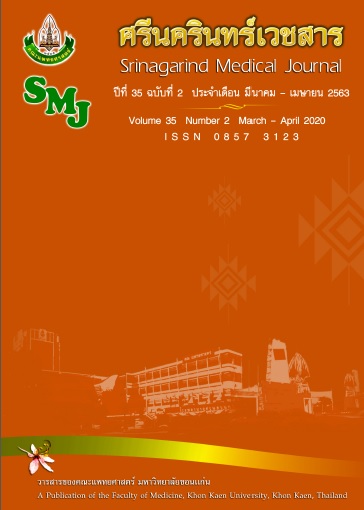Accuracy of Ultrasound-Guided Core-Needle Biopsy of Non-Palpable Breast Masses
Keywords:
การตรวจชิ้นเนื้อหลักเข็ม, เครื่องตรวจคลื่นเสียงความถี่สูง, Core-needle biopsy, Mammography, Ultrasound guidanceAbstract
ความแม่นยำของการเจาะตัดชิ้นเนื้อภายใต้การชี้นำด้วยคลื่นเสียงความถี่สูงในก้อนเนื้อเต้านมที่คลำไม่ได้ด้วยมือ
ศิริปริญญา พูนธนางกูร
กลุ่มงานรังสีวิทยา โรงพยาบาลมหาราชนครราชสีมานครราชสีมา ประเทศไทย
หลักการและวัตถุประสงค์: หลังจากที่มีการตรวจวินิจฉัยเต้านมด้วยเครื่องเอกซเรย์เต้านม ทำให้สามารถตรวจพบก้อนขนาดเล็กที่คลำไม่ได้ด้วยมือมากขึ้นจึงได้มีการนำเทคนิคการตรวจด้วยเครื่องตรวจคลื่นเสียงความถี่สูง มาใช้เพื่อกำหนดตำแหน่งก้อนและทำการเจาะตัดชิ้นเนื้อด้วยเข็มตัดชิ้นเนื้อ(ultrasound-guided core needle biopsy) แทนการผ่าตัดเต้านมแบบเปิดแผลการศึกษานี้มีวัตถุประสงค์เพื่อศึกษาความแม่นยำของผลการตรวจชิ้นเนื้อเต้านมด้วยวิธี ultrasound-guided core needle biopsy เมื่อเปรียบเทียบกับ open-excisional biopsy
วิธีการศึกษา: เป็นการศึกษาเชิงพรรณนาแบบเก็บข้อมูลย้อนหลัง ในผู้ป่วยที่มีก้อนเนื้อที่เต้านมที่โรงพยาบาลมหาราชนครราชสีมาหลังได้รับการตรวจด้วยวิธีultrasound-guided core-needle biopsy และ open-excisional biopsyแล้วนำผลการตรวจทางพยาธิวิทยาจากวิธีทั้งสองมาเปรียบเทียบกัน
ผลการศึกษา: ตั้งแต่เดือน มกราคม 2555 ถึงกรกฎาคม 2558 มีผู้ป่วยที่ได้รับการตรวจทั้งสองวิธีจำนวน 91 ราย ผลการตรวจ ultrasound-guided core-needle biopsyพบว่ารอยโรคที่ผิดปกติส่วนมากเป็นก้อนเนื้อชนิดไม่ร้ายแรงร้อยละ 68.13 ส่วนชนิดที่เกี่ยวข้องกับมะเร็งพบร้อยละ 21.98 และเมื่อนำไปเปรียบเทียบกับ open-excisional biopsy พบว่ามีผลพยาธิวิทยาตรงกัน 81 ราย
สรุป: ผลการตรวจทางพยาธิวิทยาจากultrasound-guided core-needle biopsy มีความแม่นยำตรงกับผลการตรวจทางพยาธิวิทยาจาก open-excisional biopsy สูงถึงร้อยละ 89.01(95%CI, 82.58-95.44%)ในผู้ป่วยที่มีก้อนเนื้อเต้านมขนาดเล็กคลำไม่ได้
were found. Therefore, ultrasound-guided core-needle biopsy was also introduced to identify and get sample tissue, instead of open-excisional biopsy. This study aimed to evaluate the accuracy of ultrasound-guided core-needle biopsy compared to open-excisional biopsy.
Methods: This was a retrospective descriptive study done in Maharat Nakhonratchasima hostpital breast-masses patients, after having both ultrasound-guided core-needle biopsy and open-excisional biopsy. Pathological examination results from both methods were compared.
Results: From January, 2012 to July, 2015, there were 91 patients who had been biopsied by both methods. Most abnormal pathological results from ultrasound-guided core-needle biopsy were benign in 68.13%. Cancer-related results were found in 21.98%. 81 patients had results that were in consistent with open-excisional biopsy.
Conclusion: In non-palpable breast masses, pathological examination results from ultrasound-guided core-needle biopsy had high accuracy rate of 89.1%(95%CI, 82.58-95.44%), when compared to open-excisional biopsy.
References
Liberman L. Clinical management issues in percutaneous core breast biopsy. Radiol Clin North Am. 2000; 38: 791–807.
Meyer JE, Smith DN, Lester SC, Kaelin C, DiPiro PJ, Denison CM, et al. Large-core needle biopsy of nonpalpable breast lesions. J Am Med Assoc 1999; 281: 1638–41.
Parker SH. Percutaneous large core breast biopsy. Cancer 1994; 74(1 S): 256–62.
Zhou JY, Tang J, Wang ZL, Lv FQ, Luo YK, Qin HZ, et al. Accuracy of 16/18G core needle biopsy for ultrasound-visible breast lesions. World J Surg Oncol 2014; 12: 7.
Verkooijen HM, Peeters PHM, Buskens E, Koot VCM, Borel Rinkes IHM, Mali WPTM, et al. Diagnostic accuracy of large core needle biopsy for nonpalpable breast disease: A meta-analysis. Br J Cancer 2000; 82: 1017–21.
Liberman L, Feng TL, Dershaw DD, Morris EA, Abramson AF. US-guided core breast biopsy: Use and cost-effectiveness. Radiology 1998; 208: 717–23.
D’Orsi CJ, Sickles EA, Mendelson EB, Morris EA, et al. ACR BI-RADS® Atlas breast imaging reporting and data system. Reston, VA: American College of Radiology; 2013.
Burbank F, Parker SH. Methods for evaluating the quality of an image-guided breast biopsy program. In: Parker SH. Interventional Breast Procedures. In: Feig SA, (ed.) Seminars in breast disease. Philadelphia, PA: WB Saunders, 1998; 1: 71-83.
Pijnappel RM, van Dalen A, Borel Rinkes IH, van den Tweel JG, Mali WP. The diagnostic accuracy of core biopsy in palpable and non-palpable breast lesions. Eur J Radiol 1997; 24: 120–3.
Farshid G, Downey P, Pieterse S, Gill PG. Effectiveness of core biopsy for screen-detected breast lesions under 10 mm: implications for surgical management. ANZ J Surg 2017; 87: 725–31.
Giuliani M, Rinaldi P, Rella R, Fabrizi G, Petta F, Carlino G, et al. Effect of Needle Size in Ultrasound-guided Core Needle Breast Biopsy: Comparison of 14-, 16-, and 18-Gauge Needles. Clin Breast Cancer 2017; 17: 536–43.
Huang ML, Hess K, Candelaria RP, Eghtedari M, Adrada BE, Sneige N, et al. Comparison of the accuracy of US-guided biopsy of breast masses performed with 14-gauge, 16-gauge and 18-gauge automated cutting needle biopsy devices, and review of the literature. Eur Radiol. 2017; 27: 2928–33.
Koskela AK, Sudan M, Berg MH, Kärjä VJ, Mustonen PK, Kataja V, et al. Add-on device for stereotactic core-needle breast biopsy: How many biopsy specimens are needed for a reliable diagnosis? Radiology 2005; 236: 801–9.
Verkooijen HM, Buskens E, Peeters PHM, Borel Rinkes IHM, De Koning HJ, Van Vroonhoven TJMV. Diagnosing non-palpable breast disease: Short-term impact on quality of life of large-core needle biopsy versus open breast biopsy. Surg Oncol 2002; 10: 177–81.
Bulte JP, Polman L, Schlooz-Vries M, Werner A, Besselink R, Sessink K, et al. One-day core needle biopsy in a breast clinic: 4 years experience. Breast Cancer Res Treat 2013; 137: 609–16.
Loughran CF, Keeling CR. Seeding of tumour cells following breast biopsy: a literature review. Br J Radiol 2011; 84(1006): 869–74.
Brenner RJ, Gordon LM. Malignant seeding following percutaneous breast biopsy: Documentation with comprehensive imaging and clinical implications. Breast J 2011; 17: 651–6.


